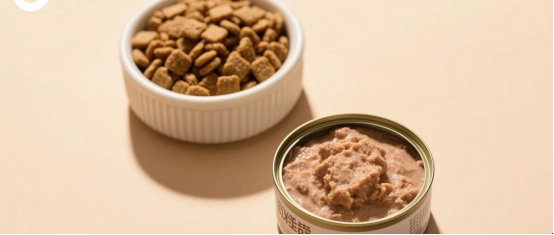
Choosing the right dog food is crucial for your dog's health, but with so many options on the market, how do you identify the best one? A bowl of high-quality dog food is not just a source of daily energy—it's key to maintaining your dog's health and extending their lifespan. This article will explore how to select the best dog food from four angles: nutritional needs, ingredient analysis, production standards, and practical buying tips, providing pet owners with actionable guidance for making informed choices.
Dogs are omnivores, but their nutritional requirements differ significantly from humans. High-quality dog food must provide a balanced mix of protein, fats, carbohydrates, vitamins, and minerals. First, protein is the cornerstone of a dog's diet, supporting muscles, skin, and the immune system. Animal-based proteins (like chicken, beef, or fish) are generally more digestible and provide essential amino acids compared to plant-based proteins. Second, fats supply energy and promote healthy skin and coats, with premium dog foods using animal fats or fish oil rather than low-quality plant oils. While not essential, carbohydrates can serve as an energy source, ideally from digestible grains or vegetables like brown rice or sweet potatoes, rather than fillers like corn or wheat bran. Additionally, vitamins and minerals (such as calcium, phosphorus, and vitamin D) are vital for bones, teeth, and overall metabolism. Understanding these needs is the foundation for evaluating dog food quality, as good dog food is formulated to meet these requirements scientifically.
The ingredient list is your window into a dog food's quality, but interpreting it requires some know-how. First, pay attention to the order of ingredients, which are listed by weight from highest to lowest. The top few ingredients make up the bulk of the food, so look for specific animal proteins like "chicken," "beef," or "deboned salmon" rather than vague terms like "meat" or "animal by-products." The latter may include low-quality meat scraps with minimal nutritional value. Next, watch out for fillers. Some budget dog foods rely heavily on corn, wheat, or soy, which may fill your dog up but are less digestible and can lead to obesity or malnutrition over time. Also, check for additives. High-quality dog foods use natural preservatives like vitamin E or rosemary extract, while avoiding synthetic chemicals like BHA or BHT, which may pose health risks. Finally, look for an AAFCO (Association of American Feed Control Officials) statement, which indicates the food meets basic nutritional standards—a useful benchmark for quality.
The production standards behind dog food directly impact its safety and quality. Premium dog foods typically come from brands with rigorous quality control, often noted on the packaging with details about the manufacturing location, ingredient sourcing, or certifications. For instance, check if the food is produced under ISO certification or follows HACCP (Hazard Analysis and Critical Control Points) guidelines, both of which ensure food safety. Additionally, research the brand's background. Reputable brands often collaborate with veterinarians and nutritionists to develop formulas tailored to different breeds, ages, and health conditions. In contrast, lower-end brands may prioritize cost-cutting, using cheap ingredients that compromise nutritional balance. You can also consult third-party reviews, such as those from Whole Dog Journal or European pet food rating sites, to gauge a brand's reputation and product quality. Be wary of brands that rely heavily on marketing hype—flashy claims don't always mean better food. Always cross-check ingredients and production details to make an informed decision.
When shopping for dog food, consider your dog's specific needs and your budget alongside ingredients and production standards. First, choose food based on your dog's age, size, and health condition. Puppies need high-protein, high-calorie formulas to support growth, while senior dogs may benefit from low-fat, easily digestible options to protect joints and digestion. Next, account for special needs. If your dog has food allergies (e.g., to grains or chicken), opt for grain-free or single-protein formulas, such as those with duck or lamb. Monitoring your dog's response to a new food is critical—good dog food should result in a shiny coat, formed stools, and high energy levels. If your dog experiences diarrhea, dull fur, or low appetite, the food may not be suitable, and you should switch. Budget-wise, premium dog foods are often pricier, but the most expensive isn't always the best. Many mid-range brands offer high-quality options with transparent ingredients at a reasonable cost. Finally, transition to new food gradually over 7-10 days by mixing it with the old food to avoid digestive upset.
Pet owners often fall into traps when choosing dog food. First, don't be swayed by "natural" or "organic" labels. These terms sound appealing but don't guarantee superior quality—focus on the ingredient list and nutritional balance instead. Second, grain-free dog food isn't always better unless your dog has a confirmed grain allergy, and it's often more expensive. Additionally, there's no need to frequently switch brands—dogs thrive on consistent diets, and unnecessary changes can upset their stomachs. Only switch if the current food isn't meeting their needs. Lastly, store dog food properly. Keep opened bags sealed to prevent moisture or oxidation, ensuring the food stays fresh and nutritious.
Selecting the best dog food involves weighing your dog's nutritional needs, scrutinizing ingredient lists, verifying production standards, and tailoring choices to your dog's unique needs. By carefully reading labels, choosing trustworthy brands, and observing your dog's health and behavior, you can find a dog food that's both nutritious and suitable. High-quality dog food is the foundation of your dog's well-being and a reflection of your care as a pet owner. Hopefully, these practical tips will guide you in picking the perfect food to keep your dog healthy and happy for years to come.





